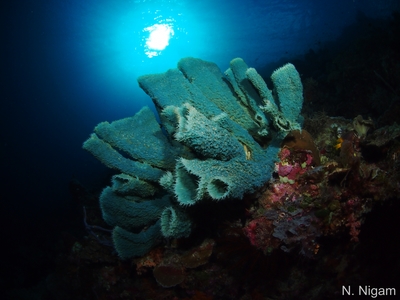One Strobe or Two?
Jul 15
One of the most commonly asked questions in the world of amateur underwater photography is “one strobe, or two?” Often this question is one of economic forethought, but it may also be a question of artistic merit. After shooting with both one strobe and two, I have come to the conclusion that with recent advancements in strobe quality and performance neither is a better option. An underwater photographer should be able to shoot beautiful photos using either option.
The use of a second strobe makes the most difference in macro photography and very wide-angle reefscapes. When shooting macro with one strobe, the light will only be coming from one direction and thus there is usually shadow in the image. A second strobe can provide light coming from a second direction which can be used to fill in shadows. This produces an image with more even lighting and less shadow/contrast.
Although many photographers prefer an image with less contrast, a single strobe usually doesn’t produce a significant enough shadow to ruin the image (if positioned correctly), and it can often be the better option when illuminating transparent organisms such as shrimp, coral and anemone polyps and some nudibranchs. If the effect with one strobe is needed, a photographer with two strobes can switch off one strobe. However, having one strobe can make a camera setup much more maneuverable while shooting macro, and there is less chance of damaging the reef.
As I mentioned before, with new, very powerful strobes such as Sea and Sea’s YS-D1, an underwater photographer can easily shoot great wide angle photographs with just one strobe. Even with a fisheye lens, I have been able to light a full frame with just one strobe. In order to do this, I will often put a diffuser with a wider angle (120 degrees) over the strobe. Because the YS-D1 is so powerful, I can still shoot the full range of wide-angle – from close focus to sunbursts. Using two strobes for wide-angle does have its merits. Two strobes will certainly brighten more of the reef and illuminate more of its details.
However, one of the most interesting effects of shooting wide-angle with one strobe is a spotlighting effect. This enables an underwater photographer to give more focus to the subject of the image. As with macro photography, if a photographer with two strobes would like the effect of one, he/she can merely turn off one of the strobes. Maneuverability is slightly less important for wide angle, because the subjects are usually not as often hidden in the crevices of the reef.

An image of coral and a sunburst taken with a single Sea and Sea YS-D1 strobe with the spotlight effect
Shooting with one or two strobes are both great options. Both produce beautiful underwater photography. It is up to the photographer to decide how much money he/she would like to spend, and if they truly want the extra range of artistic tools that a second strobe brings to the table.










Related Articles
Popular Articles